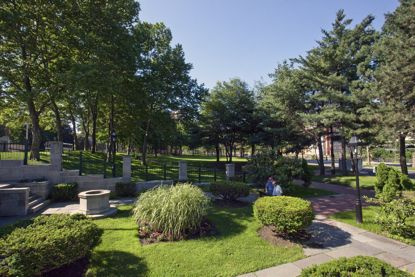For just $30 an entire
family can get into national parks like Yosemite or Yellowstone — that's thanks
to taxes.
 |
| Rhode Island's National Park: the Roger Williams National Memorial in the heart of downtown Providence |
The price tag for admission? $80.
That’s the cost of an annual pass to all of America’s national
parks. And it admits everyone in your vehicle when you visit, not just one
person.
To put that in context, that’s less than it costs one person to
visit Disneyworld’s Magic Kingdom for just one day.
Driving away from Yellowstone after five days of watching moose,
elk, bison, a black bear, and even wolves, I turned the radio to NPR and
listened to a segment on the anniversary of the parks. They were broadcasting from
Yellowstone.
“Are our parks being
loved to death?” they asked.
| And let's not forget our newest, the Blackstone River Valley National Historic Park |
Some people think that record crowds are bad for our national parks. News stories report on park visitors behaving badly, often endangering their own lives, or harming the wildlife. And there was that one incident when tourists put a baby bison in their car.
Others simply believe that their overall experience is marred by
the crowds, and that maybe parks should charge more for entry to keep people at
bay.
Disneyworld, a private business, charges the ticket price that
the market will bear, yet it still attracts crowds that result in hours-long
lines for rides.
Plus, our national parks aren’t a private entity. Profit is not
the goal.
They’re an investment for all of us in something that is greater
than the sum of its parts. And that investment is made possible by all of us.
It wouldn’t do for individuals to kick in a few bucks here and
there to protect bits and pieces of the national parks as they saw fit. Just as
it wouldn’t do for each person to build just the piece of road in front of
their house, or maintain one street light for their use.
Of course, the privilege of visiting a national park isn’t 100
percent egalitarian. We don’t all get time off of work to travel, nor can
everyone afford to drive or fly across the country, to pay for a hotel, or buy
camping gear.
But once you get there, the price tag of admission is rather
affordable. For $30, your entire family can get into Yosemite or Yellowstone.
That’s probably less than it costs for the whole family to go to the movies.
Sure, jacking up the price would probably do something about the
crowds.
But the very point of public ownership of these parks is that
everyone should be able to visit. Charging Disneyworld prices would limit
millions of Americans from experiencing them.
That’s why we pay taxes: because there are some things that we
can only afford when we pool our resources together.
Because of your tax dollars and mine, the grizzlies and geysers
of Yellowstone will not only be there for you, should you ever wish to visit,
but also for your great grandchildren. So will the roads to get there, and the
cops who keep the roads safe on the way.
If we share the value that all Americans should have access to our
parks, rich and poor alike, then we should fund them properly with tax dollars.
The same is true for all public services we share. If we don’t
want to drive on worn out bridges or pothole-filled roads, and we want top
quality public schools, we have to pay for it.
All of us, as Americans, share a common path. Despite our
rhetoric of rugged individualism, the only way to ensure that path is a good
one is to invest in it — together.
OtherWords
columnist Jill Richardson is the author of Recipe for America: Why Our Food System Is Broken and What We Can Do to
Fix It. Distributed by OtherWords.org.